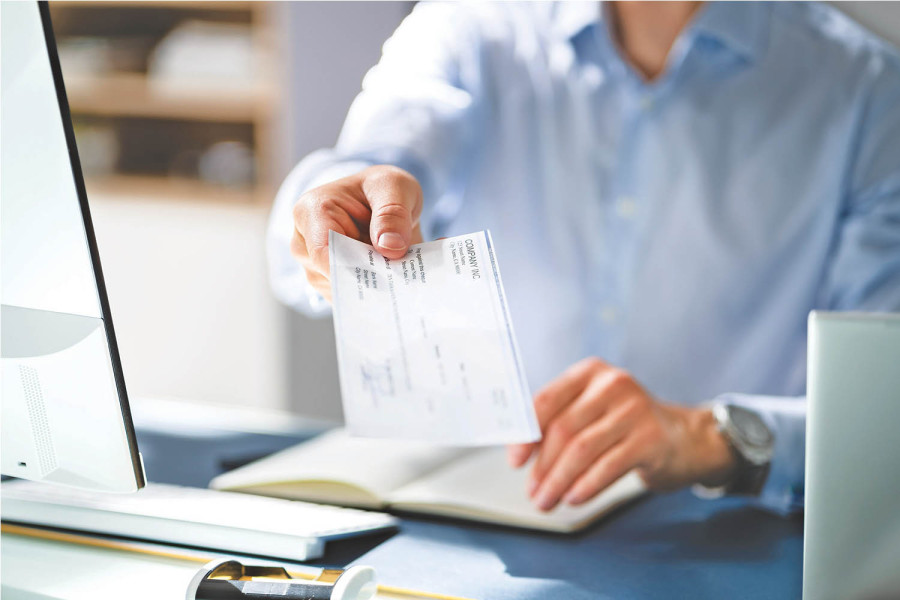Money
Nepal’s cheque era fading as digital payments take precedence
The number of cheques declined by 8.97 percent to 15.22 million, with associated cash transactions dropping to Rs7.83 trillion from Rs10.53 trillion in a year.
Krishana Prasain
The use of cheques in Nepal has markedly declined as cashless payments have become more common.
According to the Payment Oversight Report published by the Nepal Rastra Bank, the number of cheques presented at banks dropped by 8.97 percent to 15.22 million in the fiscal year 2022-23. It was 16.72 million in 2021-22.
As a result, the number of transactions done through cheques also declined to Rs7.83 trillion from Rs10.53 trillion during the review period, marking a one-fourth decline.
“Digitisation has increased dramatically over the past two years,” said Gunakar Bhatta, executive director at the Nepal Rastra Bank, the report's author.
He also said that transactions through Quick Response (QR) codes have doubled in this period.
“There has been a significant growth in mobile banking users as well.”
According to the monthly payment systems indicators, a central bank report, cash transactions through mobile banking jumped by a whopping 60.19 percent to Rs373.97 billion from mid-June to mid-July compared to the same period last year.
Mobile banking transactions jumped 45.66 million from mid-June to mid-July compared to 28.90 million in the same period last year.
QR code payments increased 104.81 percent to Rs61.73 billion in the review period. The number of transactions through QR code also increased to 20.82 million from 9.76 million during the review period.
“More people prefer transactions through mobile phones rather than cheques,” Bhatta said. “Cheques are time-consuming, whereas digital payment systems offer instant transactions, which is why they have become so popular.”
Digital payments are fast, convenient, and settled in real time.
Another official at the central bank said that the growing shift to digital payments indicates that cash transactions through cheques are unlikely to rise in the coming days.
Digital transactions offer distinct advantages, including better control of credit in business and during purchases.
“As cheque fraud is on the rise, digital payments are set to eliminate it completely,” said the central bank official.
Sanjib Subba, a fintech expert, said the decline in cheque transactions is good news, particularly as Nepal is promoting a digital payment ecosystem.
“We would like to see cheques in the museum at the earliest. The faster we shift to digital payments, the quicker we will become a cashless society.”
Currently, it costs around Rs40 to produce a cheque leaf—from printing to processing.
“So, it will reduce banks’ operation costs,” said Subba.
Commercial banks, too, agree.
“Definitely, in recent years, we have seen a massive fall in footfall at bank counters,” said Suman Pokharel, deputy CEO of Global IME Bank. “This is a result of growing digital payments.”
Pokharel added that staff formerly working in cash counter services are now being reassigned to sales and other areas of the bank.
Experts said that there are now many options to make payments digitally by staying at home.
For large transactions, there is a real-time gross settlement system. There are various options for person-to-person (P2P) payment and person-to-merchant (P2M) payments, such as Fonepay.
For corporate transactions, Nepal Clearing House Limited has introduced the ‘corporate pay’ system.
“From this perspective, cheque is now becoming less essential,” Subba said.
“Nowadays, people who visit banks are for cheque transactions for P2P or P2M services,” said Subba.
But there is still a lot to be done for the growth of digital payments.
Subba said Nepal needs to focus on developing its digital public infrastructure.
There are three components of digital public infrastructure: e-KYC (know your customer), payment rails, and a data exchange platform. The government needs to spearhead this digital public infrastructure initiative.
One of the major problems with Nepal’s digital infrastructure is poor data connectivity. The cost of data packages is too high, Subba said. “If we want to promote digital payment, the internet data cost needs to be made free.”
Data has become a basic need, Subba said.
Experts said that imposing a tax on digital payment systems could discourage users.
Through the budget, the government took counterproductive action by imposing a tax on digital payments and a 13 percent value-added tax on the goods and services that people buy through digital payment methods.
However, nearly two months after imposing the tax, on September 6, the government decided to refund 10 percent of the 13 percent tax on such services.
It announced that customers would get a 10 percent tax refund for services at bars, restaurants, hotels, motels, lodges and guesthouses. The operators are required to automatically refund the amount to the customers' accounts.
“What is the logic behind imposing taxes and then refunding them?” questioned Subba.
“The government is penalising consumers who are supporting the economy.”
He said that the refund provision has complicated things.
“How will a person get a 10 percent refund while making P2P digital payments and merchant payments not connected to the Inland Revenue Department? Ninety percent of digital payments come from P2P and P2M,” Subba said.
Digital payments have also made financial inclusion easier, as cheque payments were often cumbersome.
To promote financial inclusion, digital payments need to be sped up, Subba said.
“Digital payments have significantly boosted financial inclusion. For instance, a small tea shop owner has been able to open a bank account due to the growth in digital payments from customers,” said Pokharel of Global IME Bank.
In the future, with the continued rise of digital payments, bank branches could serve as sales outlets offering additional financial services rather than merely being customer service centres, Pokharel said.
While there has been a rise in fraudulent activities in digital payments, it is mainly due to a lack of awareness among customers, he said.




 5.83°C Kathmandu
5.83°C Kathmandu















